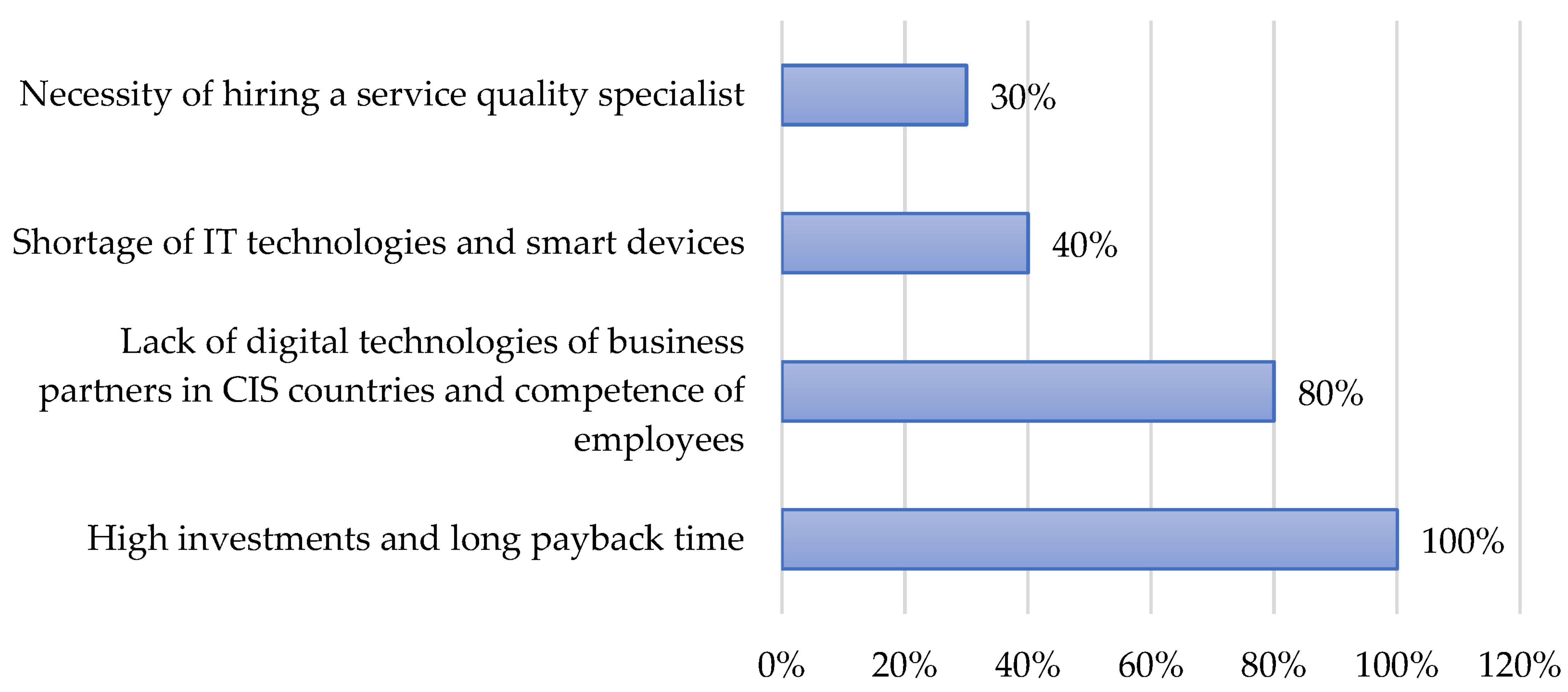3.1. Expert Survey Results
Considerable attention has been paid to analysing the significance of service quality itself and its definition. The carriage of less-than-truckload shipments by road transport on international routes involves close cooperation with business partners of various logistics terminals in different countries. A company concerned with raising the quality level of its services finds it important for the perception of quality of its partners to meet the requirements which it is subject to itself. Transhipment of less-than-truckload shipments takes place not only in local logistics centres, but also in terminals of other countries.
The analysis of the questions included in the questionnaire emphasises that the first questions allow for the assessment of how often companies use the services of their logistics partners, the quality of their work, introducing the vision and objectives of quality of their company. All the experts answered that they often use the services of their partners, as this relates to the specifics of less-than-truckload shipments. Arranging international carriage of less-than-truckload shipments without the assistance of partners would not only be unprofitable but also impossible, as covering absolutely all markets and building logistics centres in every country would be difficult for one company.
As many as 70% of the experts answered that they conduct a quality assessment once a year, while 20% of the companies surveyed conduct it twice a year. This is due to a shortage of time and the desire to save money by not having to hire quality experts from other companies. The companies’ representatives stick to the opinion that only they can best assess the quality of their services, because they understand the specifics of the work they do and are interested in the requirements of their customers. The survey found that 40% of experts do not see the point of personally communicating quality indicators to their partners, because the company’s employees, who interact with their partners every day, constantly set requirements for their work that are in line with their set quality criteria.
In total, 30% rated the work of their partners as good because companies of these experts in particular check the quality indicators of their partners and customers at least twice a year and try to keep up to date with new requirements from customers, also analysing changes in the market in terms of quality.
The expert evaluation sought to identify the quality criteria that affect the perception of quality of services that customers of their companies have. The following criteria were evaluated in the research: K1—flexibility of service, K2—ability to provide solutions and proposals, K3—ability to offer customs brokerage services, K4—ability to offer door-to-door carriage, K5—timely provision of information through digital technologies, K6—ability to provide additional services, K7—order execution within the set timeframe, K8—ensuring the security of shipments. The sum of the ranks, the mean of the ranks, the difference between the sum of the ranks and the fixed value, and the square of the difference were calculated for these criteria (
Table 3).
Formulae were used to calculate the sum of the ratings and the means of the ratings for each of the quality criteria using a ranking method, thus obtaining the relationship between the scores and the ratings. The sum of the significance coefficient is equal to the sum of the mean of the ratings, which is 33.4. The difference between the fixed value and the sum of the ratings for each criterion and the square of the difference was calculated.
Since there are no correlated ranks, Kendall concordance coefficient was calculated, obtaining the value W = 0.6729. This coefficient is greater than 0.5, which allows concluding that the opinions of all experts interviewed are concordant.
Since the number of criteria in quality assessment is greater than 7, i.e., m > 7, the weight of the concordance coefficient is calculated using the (chi-quadrat) Pearson criterion.
= 47.1 or more than which is equal to 20.092, thus expert opinions are considered concordant.
The calculation of the lowest concordance coefficient = 0.2870 << 0.6729 allows concluding that the opinions of the interviewed experts are concordant.
The calculations performed allow stating that the expert opinions of the provided eight criteria that affect the perception of service quality by company customers are concordant and summarised.
Subsequently, criteria importance indicators presented in
Table 4 were calculated.
The Qj indicator not only measures the importance of one criterion over another, but also how many times one indicator is more important than others. K5 and K8 referring to timely provision of information and the security of freight were the most important factors, and K3 and K6, or the ability to provide customs brokerage services and additional services, such as freight insurance and labelling, were the least important factors.
However, in addition to determining the importance of a criterion, it is important to identify how the customer service quality criteria mutually influence each other’s results (
Figure 2).
As the results show, customer service quality criteria fell into two dependency groups, which can be evaluated as: (1) The most correlated factors: Flexibility of service and Ability to provide solutions and proposals are most correlated with Order execution within the set timeframe; Ability to offer customs brokerage services is most correlated with Ability to provide additional services and Ability to offer door-to-door carriage; Timely provision of information through digital technologies is most correlated with Ensuring the security of shipments; Order execution within the set timeframe is most correlated with Flexibility of service and Ability to provide solutions and proposals. (2) Factors forming medium correlation relations: all the rest, not mentioned in point 1.
In summary, it can be said that the obtained results show the closeness of the data and, at the same time, the causes.
The service quality criteria which partner companies are subject to were further analysed. Experts’ answers are listed in
Table 5 and their rating is presented in
Table 6.
Formulae were used to calculate the sum of the ratings and the mean of the ratings for each of the quality criteria using a ranking method, thus obtaining the relationship between the scores and the ratings. The sum of the significance coefficient is equal to the sum of the mean of the ratings, which is 39.8. The difference between the fixed value and the sum of the ratings for each criterion and the square of the difference was calculated.
The Kendall concordance coefficient calculation methodology was used In the analysis of the service quality criteria which business partners are subject to, obtaining the value of W = 0.792. This coefficient shows that the opinions of all experts interviewed are concordant.
Since the number of criteria in quality assessment is greater than 7, i.e., m > 7, the weight of the concordance coefficient is calculated using the (chi-quadrat) Pearson criterion.
When = 63.36 or more than , which is equal to 20.092, respondent opinions are considered concordant.
Having calculated the lowest concordance coefficient value of = 0.2511 << 0.6729, the opinions of the experts interviewed are considered concordant.
The conducted calculations allow stating that expert opinions match on the nine presented criteria, which affect the service quality of company partners.
Subsequently calculated criteria importance indicators are presented in
Table 7.
The Qj indicator allows determining not only how much one indicator is more important than another, but also how many times one indicator is important than others.
Having assessed the service criteria that companies which frequently use services of their logistics partners to assist them with international freight carriage on international routes find important, the expert group concluded that the key quality criteria were I and F, or the introduction of digital technology and the professionalism of employees, while C and H, or a rapid carriage to their international logistics terminal and the ability to provide assistance in the processing of the necessary documentation, were less important.
After assessing the compatibility of business partners’ leases, it was also important to identify how the service quality criteria set for company partners correlate with each other (
Figure 3).
These results also showed that the service quality criteria for corporate partners fell into two dependency groups, which can be evaluated as: (1) The most correlated factors: Flexibility of working hours is most correlated with Timely processing of new orders, Employee professionalism, Warehousing and handling services for servicing freight and Introduction of digital technologies; Fast transportation to the international logistics terminal is most correlated with Ability to provide assistance for the necessary paperwork procedures; The agreed works performed on time is most correlated with Provision of solutions to the problem. (2) Factors forming medium correlation relations: all the rest, not mentioned in point 1.
In the analysis of the extent of implementation of digital technologies in companies involved in international carriage of less-than-truckload shipments, the majority of experts were found to use such technologies in their business. In total, 70% of experts agreed that they have been implementing such technologies and only 30% of experts said they did not use them. The experts, who comprise 30% of the respondents, represent small companies that are not capable of investing in digital technologies. Such investments would account for a significant share of their profits, thus they are not ready to invest in such technologies, even though they demand the adoption of such technologies from their business partners, most of whom represent large companies.
The assessment of digital technology measures which companies are implementing revealed extensive use of electronic documents and orders (70%), the planning of routes and freight loading (50%), and measures for determining vehicle location in real time (50%).
None of the experts chose an integrated electronic system involving customers and business partners (carriers and international logistics terminal partners) and an electronic application for the company’s customers.
The conducted expert research revealed that companies organising less-than-truckload shipments on international routes have been improving the quality of their services through the use of digital technologies.
The research results revealed that companies’ customers appreciate prompt provision of information through digital technologies the most.











